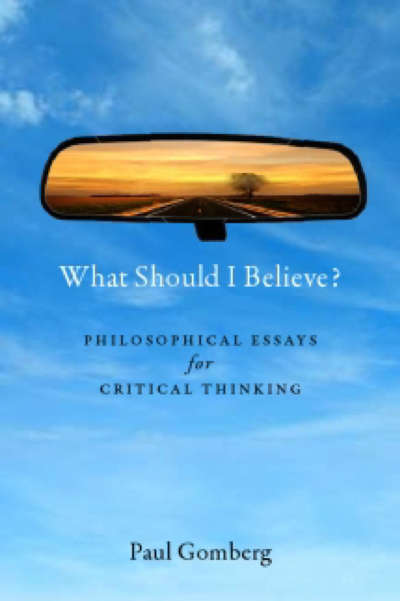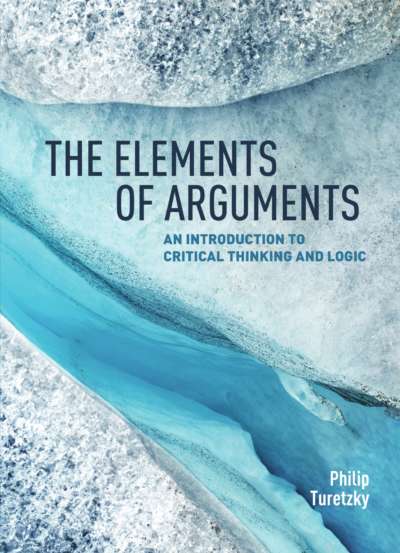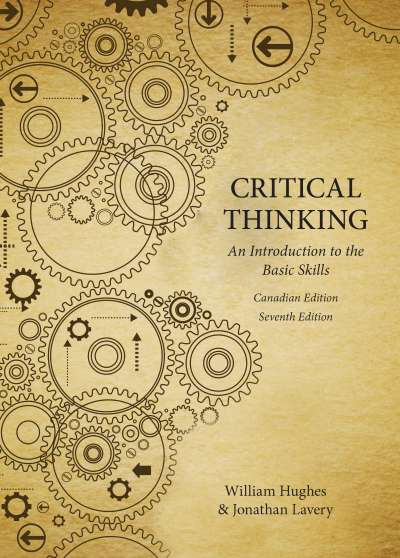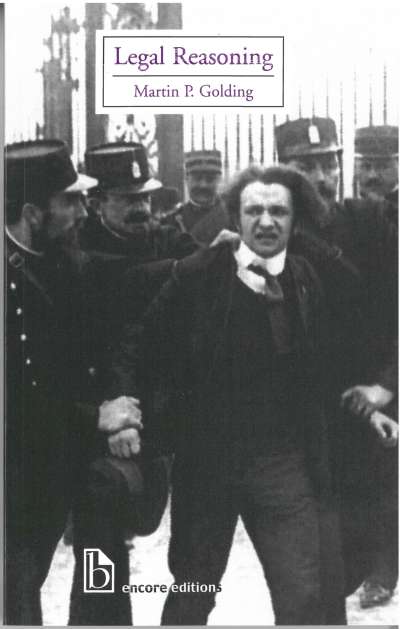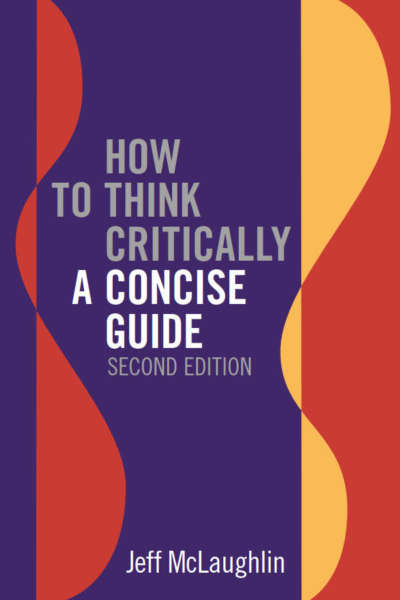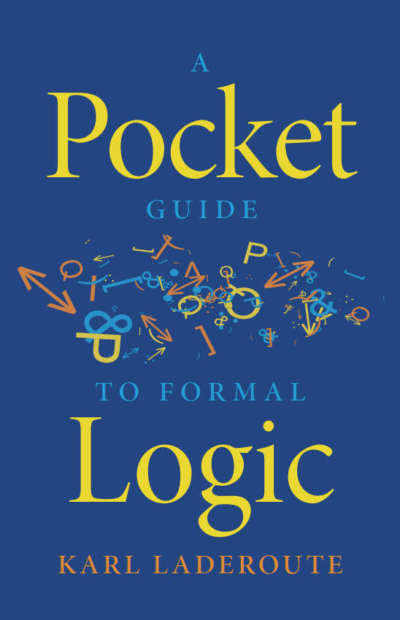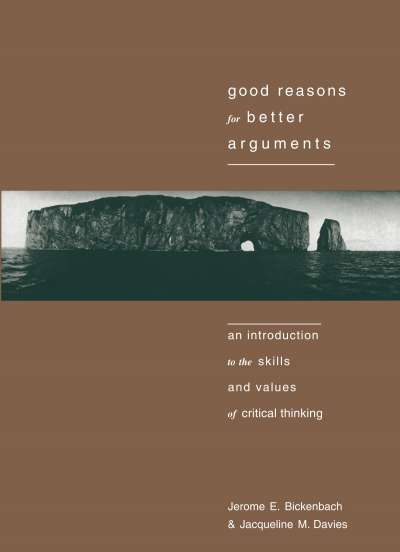The Critical Thinking Book covers not only standard topics such as definitions, fallacies, and argument identification, but also other pertinent themes such as consumer choice in a market economy and political choice in a representative democracy. Interesting historical asides are included throughout, as are images, diagrams, and reflective questions. A wealth of exercises is provided, both within the text and on a supplemental website for instructors. The author also offers additional exercises, videos, and other teaching and study materials that can be digitally integrated into Learning Management Systems.
Comments
“Gary James Jason has pulled off something that I have long hoped for—one book that covers all the necessary components of critical thinking. This text offers such a range of methods and approaches that it gives instructors choice as to how to map out their courses. I find the Concept Maps, thought questions, and historical accounts of important thinkers to be great supplements to the main text. The author uses cool examples such as dialogues and advertisements, and these visual components make the book fun and engaging for students.” — Jacqueline Alvarez, California State University, Fresno
“The Critical Thinking Book is an excellent choice for courses in critical thinking, rhetoric, and informal logic. The cross-disciplinary approach is engaging, and the contemporary examples from fields such as marketing and politics will hold the reader’s attention. Students will benefit considerably from the abundant exercises and the Concept Map in each chapter. This is a text that instructors will want to use and students will want to read.” — Jeff Lawrence, North Island College
“The Critical Thinking Book provides remarkably thorough coverage of the main topics in this field. As a critical thinking instructor, I have been looking for a text that strikes a balance between formal and informal reasoning; Jason's book does this well, as it is comprehensive in its coverage without being overly technical.” — Tuomas Manninen, Arizona State University
“Critical thinking necessitates clear thinking; thus, the clarity of this text lends itself well to its subject matter. This book will help individuals escape the prison of fallacious thinking and avoid being manipulated by flawed logic and faulty reasoning, highlighting the importance of mastering thinking rationally in an age in which many do not. Whether the reader is completely new to critical thinking or already has an intermediate understanding of the discipline, they will surely find this book both engaging and useful. If you desire to improve your mental capabilities, this book is for you.” — Asha Lancaster-Thomas, Teaching Philosophy
Preface
Part One: The Elements of Critical Thinking: Statements, Questions, Arguments, Cases, and Dialogues
- Chapter 1: Critical Thinking: Developing an Effective Worldview
- 1. Critical Thinking and Mental Models
- 2. Clarity and Consistency
- 3. Relevance
- 4. Justification and Explanatory/Predictive Power
- 5. The Usefulness of Critical Thinking
- 6. Impediments to Critical Thinking
- 7. Critical Thinking as an Academic Discipline
- 8. The Organization of This Book
- Chapter 2: Assertions
- 1. Assertions and Sentences
- 2. Statement Forms: Simple and Compound
- 3. Statement Forms: Particular and General
- 4. Statement Content: Necessary versus Contingent
- 5. Statement Content: Descriptive versus Evaluative
- Chapter 3: Questions
- 1. Questions and Sentences
- 2. Types of Questions
- 3. Responsive Answers
- 4. Fallacies of Questions
- Chapter 4: Identifying Single Arguments
- 1. Premises and Conclusions
- 2. Identifying Single Arguments: Rhetorical Devices
- 3. Identifying Single Arguments: Rhetorical Expansion
- 4. Identifying Single Arguments: Rhetorical Compression
- 5. Telling Arguments from Other Things
- 6. The Uses of Arguments
- 7. Two Types of Evidential Relations
- 8. Deductive Argument Forms
- 9. Inductive Argument Forms and the IBE
- Chapter 5: Multiple Arguments, Cases, and Dialogues
- 1. Diagramming Multiple Arguments
- 2. The Case Structure
- 3. The IBE as a Compressed Case
- 4. Dialogues
Part Two: The Goals of Critical Thinking: Clarity, Relevance, Consistency, Justification, and Explanatory Power
- Chapter 6: Pitfalls of Language
- 1. Pitfalls of Language
- 2. Verbosity and Jargon
- 3. Vagueness
- 4. Loaded Language and Circular Argument
- 5. Understatement and Overstatement
- 6. Ambiguity
- 7. Synonymy
- 8. Figurative Language
- 9. Review of Major Fallacies Discussed so Far
- Chapter 7: Definition, Classification, and Concept Mapping
- 1. Three Tools for Organizing Thought and Clarifying Language
- 2. Types of Definition
- 3. Sense and Reference
- 4. Methods of Definition
- 5. Rules for Explicit Definitions
- 6. Analogical Definition
- 7. Classification
- 8. Concept Mapping
- Chapter 8: Topical Relevance
- 1. Relevance and Questions
- 2. Fallacies of Refusing to Answer
- 3. Fallacies of Irrelevant Emotional Appeal
- 4. Fallacies of Ignoring the Issue
- 5. How to Explain Fallacies of Relevance
- 6. Review of the Major Fallacies Discussed so Far
- Chapter 9: Deductive Reasoning I: Truth-Functional Logic
- 1. Two Types of Consistency
- 2. Cognitive Dissonance Theory
- 3. Basic Concepts of Deductive Logic
- 4. Truth Table Calculations
- 5. Symbolization
- 6. Truth Table Testing for Consistency
- 7. Truth Table Testing for Implication and Validity
- 8. Truth Table Testing for Other Deductive Concepts
- 9. Summary
- Chapter 10: Deductive Reasoning II: Class Logic
- 1. A Closer Look at Statements
- 2. Statements Involving Two Classes
- 3. Venn Testing for Consistency
- 4. Venn Testing for Implication and Validity
- 5. Venn Testing for Other Concepts
- 6. Summary of Concepts
- 7. The Limitations of Truth-Functional and Class Logic
- Chapter 11: Inductive Reasoning I: Observation, Memory, and Testimony
- 1. Sensing, Observing, and Reporting
- 2. Assessing Observation
- 3. Special Issues Concerning Observation in Natural Science
- 4. Assessing Memory
- 5. Assessing Eyewitness Testimony
- 6. Assessing Expert Testimony
- 7. The Fallacy of Faulty Appeal to Authority
- 8. Special Issues Concerning Expert Testimony in Journalism
- 9. Special Issues Concerning Expert Testimony in Legal Proceedings
- 10. Observation, Memory, and Testimony as IBE and CBE
- Chapter 12: Inductive Reasoning II: Inductive Generalization and Inductive Instantiation
- 1. The Pervasiveness of Inductive Generalization
- 2. Criteria for Assessing Generalizations
- 3. The Fallacy of Faulty Generalization
- 4. Defeasibility and General Rules
- 5. The Statistical Syllogism
- 6. The Fallacy of Faulty Instantiation
- 7. A Common Confusion
- 8. Inductive Generalization and Inductive Instantiation as IBE and CBE
- 9. Stereotypes and Prejudice
- Chapter 13: Inductive Reasoning III: Analogies
- 1. The Uses of Analogy
- 2. Descriptive and Definitional Analogies
- 3. Assessing Analogical Arguments
- 4. The Heuristic Use of Analogies
- 5. Models in Science
- 6. Analogies in Legal Reasoning
- 7. Analogical Arguments as IBE and CBE
- Chapter 14: Inductive Reasoning IV: Causal Inference
- 1. The Relation of Cause and Effect
- 2. Evidence for Causal Claims: Temporal and Statistical Linkages
- 3. Establishing Deterministic Causes
- 4. A More Formal Approach to Causal Reasoning
- 5. Establishing Statistical Causes
- 6. Special Issues in Medical and Pharmaceutical Research
- 7. The Fallacy of Faulty Causal Reasoning
- 8. Causal Inference as IBE and CBE
- 9. Review of the Five Inductive Fallacies
- 10. Review of All of the Previous Major Fallacies
- Chapter 15: Inductive Reasoning V: Explanation, Hypothesis, and Prediction
- 1. Key Concepts
- 2. Types of Explanation
- 3. A Closer Look at Causal Explanations
- 4. Rules for Forming Hypotheses
- 5. Rules for Assessing Hypotheses
Part Three: Applications of Critical Thinking: Decisions in a Democratic Market Economy
- Chapter 16: Classical Decision Theory: Its Uses and Problems
- 1. Utility and Preferences
- 2. Decision under Certainty: The Rational Choice Model
- 3. Decision under Risk
- 4. Decision under Uncertainty
- 5. Decision under Conflict
- 6. Challenges to Classical Decision Theory I: Several Narrow Criticisms
- 7. Challenges to Classical Decision Theory II: The Opacity of Costs and Benefits
- 8. Challenges to Classical Decision Theory III: Behavioral Decision Theory
- 9. Challenges to Classical Decision Theory IV: Manipulation by Others
- Chapter 17: Application I: Rational versus Irrational Marketing
- 1. Two Main Branches of Rhetoric
- 2. When Is Marketing Rational?
- 3. Why Is Marketing so Often Irrational?
- 4. Psychological Mechanisms Exploited by Marketing Agents
- 5. Examples of Irrational Marketing Techniques
- 6. Special Issues in Advertising to Children
- 7. How to Combat Deceptive Marketing
- Chapter 18: Application II: Rational versus Irrational Propaganda
- 1. Political Agents and Propaganda
- 2. Is Deceptive Propaganda More Prevalent Than Deceptive Marketing?
- 3. Examples of Irrational Propaganda Techniques
- 4. How to Combat Deceptive Propaganda
- 5. Propaganda in a Dictatorship
- Chapter 19: Application III: Science versus Pseudo-Science
- 1. Healthy Science versus Pseudo-Science
- 2. Symptoms of Pseudo-Science
- 3. First Example of Pseudo-Science: Astrology
- 4. Second Example of Pseudo-Science: Lysenkoism
- 5. A Borderline Case
Glossary
Bibliography
Permissions Acknowledgments
Index
Gary James Jason is a Senior Lecturer at California State University, Fullerton, where he was given a “Best Teaching Award” at the Irvine campus and an “Outstanding Lecturer Award” at the main campus.
To read a sample from chapter 1 of The Critical Thinking Book click here.


